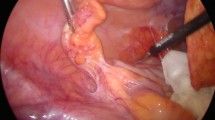Abstract
Based on the available urogynecological literature, the role of hysterectomy in the surgical strategy of pelvic organ prolapse (POP) repair remains controversial. Currently, there are no data to favor either the removal or preservation of the uterus in women with POP. The findings that hysterectomy may contribute to a higher success rate and to the development of urinary incontinence and/or female sexual dysfunction are not supported by evidence. It is not clear why both hysteropexy was sometimes performed in the presence of overt uterine prolapse and/or concomitant vaginal hysterectomy was often included in vaginal prolapse repair in the absence of uterine prolapse. In our opinion, it makes both anatomical and clinical sense to remove the uterus only (and always) when the uterus is one of the pelvic organs directly involved in the prolapse, but to preserve and suspend the uterus otherwise.
Similar content being viewed by others
References
Maher C, Baessler K, Barber M, et al. Pelvic organ prolapse surgery. In: Abrams P, Cardozo L, Khoury S, Wein A, editors. 5th International Consultation on Incontinence. Paris: Health Publications; 2013. p. 1393.
Nichols DH. What is new in vaginal surgery? Int Urogynecol J Pelvic Floor Dysfunct. 1996;7:115–6.
Baggish MS. Total and subtotal abdominal hysterectomy. Best Pract Res Clin Obstet Gynaecol. 2005;19:333–56.
Barranger E, Fritel X, Pigne A. Abdominal sacrohysteropexy in young women with uterovaginal prolapse: long-term follow-up. Am J Obstet Gynecol. 2003;189:1245–50.
Dietz V, Schraffordt Koops SE, van der Vaart CH. Vaginal surgery for uterine descent; which options do we have? A review of the literature. Int Urogynecol J Pelvic Floor Dysfunct. 2009;20:349–56.
Rhodes JC, Kjerulff KH, Langenberg PW, Guzinski GM. Hysterectomy and sexual functioning. JAMA. 1999;282:1934–41.
Zucchi A, Costantini E, Mearini L, Fioretti F, Bini V, Porena M. Female sexual dysfunction in urogenital prolapse surgery: colposacropexy vs. hysterocolposacropexy. J Sex Med. 2008;5:139–45.
Altman D, Granath F, Cnattingius S, Falconer C. Hysterectomy and risk of stress-urinary-incontinence surgery: nationwide cohort study. Lancet. 2007;370:1494–9.
Miller JJ, Botros SM, Beaumont JL, et al. Impact of hysterectomy on stress urinary incontinence: an identical twin study. Am J Obstet Gynecol. 2008;198:565.e1–4.
Collinet P, Belot F, Debodinance P, Ha Duc E, Lucot JP, Cosson M. Transvaginal mesh technique for pelvic organ prolapse repair: mesh exposure management and risk factors. Int Urogynecol J Pelvic Floor Dysfunct. 2006;17:315–20.
Baden WF, Walker T. Surgical repair of vaginal defects. Philadelphia: Lippincott; 1992.
Summers A, Winkel LA, Hussain HK, DeLancey JO. The relationship between anterior and apical compartment support. Am J Obstet Gynecol. 2006;194:1438–43.
Huffaker RK, Kuehl TJ, Muir TW, Yandell PM, Pierce LM, Shull BL. Transverse cystocele repair with uterine preservation using native tissue. Int Urogynecol J Pelvic Floor Dysfunct. 2008;19:1275–81.
Madhu C, Foon R, Agur W, Smith P. Does traction on the cervix under anaesthesia tell us when to perform a concomitant hysterectomy? A 2-year follow-up of a prospective cohort study. Int Urogynecol J Pelvic Floor Dysfunct. 2014;25:1213–7.
Author information
Authors and Affiliations
Corresponding author
Ethics declarations
Conflicts of interest
None.
Rights and permissions
About this article
Cite this article
Serati, M., Rizk, D. & Savatore, S. In the footsteps of Bonney and Nichols: hysterectomy during surgical repair of pelvic organ prolapse. Int Urogynecol J 28, 823–825 (2017). https://doi.org/10.1007/s00192-016-3163-9
Received:
Accepted:
Published:
Issue Date:
DOI: https://doi.org/10.1007/s00192-016-3163-9




